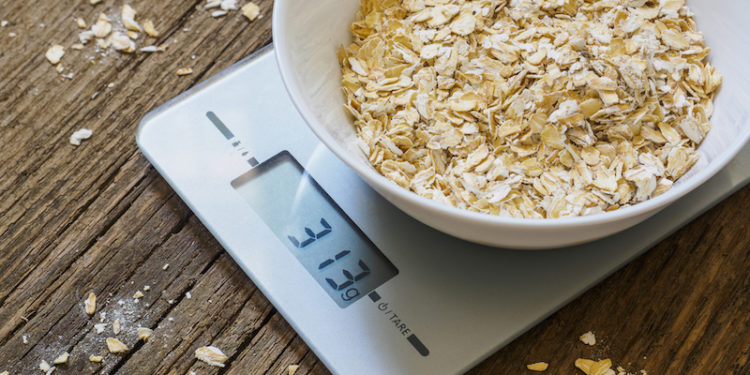There’s no shortage of self-proclaimed gurus who swear that this pill or that herb is the secret to easy weight loss, but here’s the cold, hard truth: only calories dictate how much you weigh, and a BMR calculator will help you gain muscle and lose fat. The body burns a certain number of calories every day and if you eat over that number you gain weight, if you eat under that number you lose weight.
Our goal here is to help you figure out what that number is. Once you know your basal metabolic rate, or your BMR, you can figure out how many calories you should be eating to accomplish your goal, be it muscle gain or fat loss. The answer is individual and the number below is just an estimate, a place to start — no one can claim their calculator does anything more — but this is the best calculator to help you get there.
Editor’s note: The content on BarBend is meant to be informative in nature, but it shouldn’t take the place of advice and/or supervision from a medical professional. The opinions and articles on this site are not intended for use as diagnosis, prevention, and/or treatment of health problems. Speak with your physician if you have any concerns.
BMR Calculator
Your BMR Result: Calories Per Day
| Activity Level | Calories |
|---|---|
| Sedentary: little or no exercise | |
| Exercise 1-3 times/week | |
| Exercise 4-5 times/week | |
| Daily exercise or intense exercise 3-4 times/week | |
| Intense exercise 6-7 times/week | |
| Very intense exercise daily, or physical job |
Exercise: 15-30 minutes of elevated heart rate activity.
Intense exercise: 45-120 minutes of elevated heart rate activity.
Very intense exercise: 2+ hours of elevated heart rate activity.
How We Calculate Your Calories
There are a few popular formulas out there and the two we landed on are considered the most accurate.
Mifflin St Jeor
Considered just a little more accurate than the other big BMR formula (which is called Harris Benedict), the Mifflin St Jeor formula is what we used to ascertain your BMR if you don’t know your body fat percentage.(1) It looks like this:
Where s is +5 for males and −161 for females.
As you can see, it takes into account a person’s weight, height, and age. This is the formula we use in the calculator above if you don’t know your body fat percentage.
Katch-McArdle
This formula, sometimes called the Cunningham formula, is more accurate. But the “katch” is that you need to know your body fat percentage, and almost nobody does. Most people who claim to are estimating their body fat based on a self assessment. (“I’ve got a four-pack, not quite a six-pack, so I’m probably 14 percent.”)
This is the formula:
Where ℓ is a person’s lean body mass, or their total weight minus their body fat percentage.
Katch-McArdle is likely the best formula, but only if you’re being accurate with your numbers — and that means making an appointment to get a DEXA scan to truly measure your body fat. Don’t want to? Stick to Mifflin St Jeor.
What Is Basal Metabolic Rate?
Calories are energy and your body is a machine that burns them. One calorie is the amount of energy needed to increase the temperature of 1 gram of water by 1 degree Celsius, and your basal metabolic rate refers to the amount of energy needed to carry out its most basic functions, like digesting food and keeping your organs functioning.
In other words, your BMR is the number of calories you would burn if you spent all day in bed, not moving.
BMR vs. TDEE
Of course, the average person doesn’t lie in bed all day without moving a muscle. This is where we see the difference between Basal Metabolic Rate (BMR) and Total Daily Energy Expenditure (TDEE).
Basal Metabolic Rate: The amount of calories you burn at rest.
Total Daily Energy Expenditure: The amount of calories your body burns from all of its activities.

How Many Calories Do I Burn In a Day?
So how can you take your BMR and use this information to know how many calories you should eat to lose weight?
Work Out Your Activity Level
To work that out, you need to take your BMR and add to it the number of calories you burn from your daily activities. How many calories they burn, unfortunately, depends on your height and weight and body composition and a few other factors, but again, we can figure out a rough estimate.
Harvard Medical School came up with this list of estimates for the amount of calories burned per 30 minutes of activity — note that even sitting and watching TV burns some calories on top of your BMR.
| Activity | 125lb person | 155lb person | 185lb person |
| Watching TV | 23 | 28 | 33 |
| Reading: sitting | 34 | 42 | 50 |
| Standing in line | 38 | 47 | 56 |
| Computer Work | 41 | 51 | 61 |
| Walking: 3.5 mph (17 min/mi) | 120 | 149 | 178 |
| Weight Lifting: general | 90 | 112 | 133 |
| Stretching, Yoga | 120 | 149 | 178 |
| Weight Lifting: vigorous | 180 | 223 | 266 |
| Stair Step Machine: general | 180 | 223 | 266 |
| Hiking: cross-country | 180 | 223 | 266 |
| Bicycling, Stationary: moderate | 210 | 260 | 311 |
| Rowing, Stationary: moderate | 210 | 260 | 311 |
| Circuit Training: general | 240 | 298 | 355 |
| Rowing, Stationary: vigorous | 255 | 316 | 377 |
| Boxing: sparring | 270 | 335 | 400 |
| Rope Jumping | 300 | 372 | 444 |
| Swimming: laps, vigorous | 300 | 372 | 444 |
| Bicycling, Stationary: vigorous | 315 | 391 | 466 |
| Running: 7.5 mph (8 min/mile) | 375 | 465 | 555 |

NEAT and Your BMR
While that table might help, you should also note that different people have different amounts of NEAT, which stands for non-exercise activity thermogenesis. Some folks walk a lot, others drive most places. Some drink a lot of water, so they get up to pee more often, which can add up to a lot more calories burned. Even fidgeting seems able to burn hundreds of extra calories per day from that.(2)
If that looks like a lot to keep in mind, consider picking up an activity tracker you can wear on your wrist, like a WHOOP strap, which will do a good job of estimating your TDEE.

How to Track the Calories You Eat
The best way to get a really good idea of how many calories you should eat to lose weight is to monitor your food intake and your weight every day for about a month. Keep track of when you’re gaining weight and when you’re losing it. After a few weeks of trial and error, you’ll have a number that you can work with.
Apps
So how do you track calories? The most effective way is with a scale and an app, like MyFitnessPal or Calorie King, which have databases to tell you how many calories are in a certain food, plus you can save your favorite recipes or meals — 1 tablespoon oil, 6 ounces chicken thighs, 1 cup rice, etc. — so that if you repeat meals, you don’t have to repeat all the work of entering it in.
The “Hand” Method
Some prefer simpler ways of working out their calories, like “the hand technique”: figure out how many calories are in a piece of meat about the size of your palm and have one or two of those per meal with four “fingers” of carbs, etc.
If you do this enough, you’ll be able to know the calorie content of some meals without needing to bring out your scales every time you eat, but it’s still smart to get an app so you can enter your calorie information and track it without needing to lug a notebook with you everywhere.

How Many Calories Should I Eat to Lose Weight?
This is a question about your calorie deficit: once you know the calories you burn in a day, how many should you eat to lose weight?
In order to lose weight, you should eat less than your daily calorie burn, because the body will then use stored fat for energy once it’s not getting enough energy from your diet. This, in turn, causes weight loss.
It’s generally understood that a good rate of weight loss is one to two pounds per week, and that a deficit of 3,500 calories will likely produce a pound of weight loss. Again, this varies from person to person and it’s important to speak with a doctor before attempting a weight loss plan, but in broad strokes, most agree that a goal of one pound of weight loss, or a 3,500-calorie deficit per week, is reasonable.
Let’s say your BMR is 2,500 calories per day. To lose a pound of weight a week, you can take the approach of eating at a 500-calorie deficit every day to produce a 3,500-calorie deficit at the end of the week, like this:
- Monday: 2,000 calories
- Tuesday: 2,000 calories
- Wednesday: 2,000 calories
- Thursday: 2,000 calories
- Friday: 2,000 calories
- Saturday: 2,000 calories
- Sunday: 2,000 calories
- Total deficit for the week: 3,500 calories

You can also cycle calorie intake throughout the week. Many find it beneficial to eat more calories on days they exercise, so another strategy that might be useful for gymgoers would be:
- Monday (workout day): 2,500 calories
- Tuesday (rest day): 1,500 calories
- Wednesday:(workout day) 2,500 calories
- Thursday (rest day): 1,500 calories
- Friday (workout day): 2,500 calories
- Saturday (rest day): 1,750 calories
- Sunday (rest day): 1,750 calories
- Total deficit for the week: 3,500 calories
Some even prefer to fast for an entire day once a week — which in this case would produce a 2,500-calorie deficit at once — or to skip breakfast a few days a week to get to that deficit. So long as the deficit is the same by the end of the week (meaning you haven’t “made up” the calories you skipped by eating more later), there’s not a lot of evidence that any method of getting to that deficit is superior.(3)

Wrapping Up
Remember that your BMR is an estimate, it’s a number to work with and it’s a great place to start, but it’s smart to do the extra work of weighing yourself regularly and tracking your food intake to really nail down the right number for you. Just make sure you speak with a physician or a dietitian before making big changes to your diet or supplement regimen.
Frequently Asked Questions
How many calories do I burn in a day?
You can use this calculator to work out your basal metabolic rate (BMR) and find that out. The best formulas to use are Mifflin St Jeor (if you don’t know your body fat percentage) and Katch-McArdle if you do.
What is a BMR?
This stands for Basal Metabolic Rate, and it’s the number of calories you burn at rest — without taking into account the extra calories you burn as you move throughout the day.
How many calories should I eat to lose weight?
After finding out how many calories you burn in a day, a typical goal is to lose one pound per week, which can be achieved by eating, on average, 500 calories under your your daily calorie burn. Make sure you talk to a doctor before starting a weight loss plan.
References
1. Frankenfield D, et al. Comparison of predictive equations for resting metabolic rate in healthy nonobese and obese adults: a systematic review. J Am Diet Assoc. 2005 May;105(5):775-89.
2. Koepp GA, et al. Chair-based fidgeting and energy expenditure. BMJ Open Sport Exerc Med. 2016 Sep 1;2(1):e000152.
3. Catenacci VA, et al. A randomized pilot study comparing zero-calorie alternate-day fasting to daily caloric restriction in adults with obesity. Obesity (Silver Spring). 2016 Sep;24(9):1874-83.
Featured image via Anton Belo/Shutterstock


